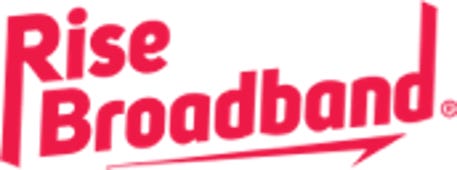Best Rural Internet Providers of 2024

CenturyLink – Best rural internet provider overall
- Prices: $55 per month
- Speeds: 10 – 140Mbps
- Key Info: Unlimited data, no contracts

Rise Broadband – Best rural fixed wireless ISP
- Key Info: Unlimited data on some plans, low price increase
- Prices: $45 – $65 per month
- Speeds: 25 – 50Mbps

T-Mobile 5G Home Internet – Best rural 5G home internet provider
- Prices: $50 per month
- Speeds: 72 – 245Mbps
- Key Info: Unlimited data, equipment included, no contracts, no additional fees
Kinetic by Windstream – Fast DSL internet speeds in rural areas
- Prices: $40 – $70 per month
- Speeds: 100 – 1,000Mbps
- Key Info: Unlimited data, no contracts

HughesNet – Best satellite internet provider
- Prices: $50 – $150 per month
- Speeds: 15 – 50Mbps
- Key Info: No hard data cap, nationwide availability

Mediacom – Best cable ISP for rural areas
- Prices: $25 – $80 per month
- Speeds: 100 – 1,000Mbps
- Key Info: Up to 6TB monthly data allowance, low introductory rates, no contracts

Ziply Fiber – Fastest rural internet provider
- Prices: $40 – $300 per month
- Speeds: 100 – 10,000Mbps
- Key Info: Unlimited data, no contracts, fast rural internet connection
Best rural internet providers overall
When shopping for internet in rural areas, start by seeking out wired connections, like the one you get with CenturyLink, our pick for the best rural internet provider overall. They can be harder to come by, but will likely be your best option for speed and reliability if it’s available.
CenturyLink’s DSL network covers suburban and rural areas across 16 states and is capable of delivering speeds as fast or faster than satellite internet without the data caps, contracts or high latency that come with satellite service. Other wired rural ISPs such as Kinetic by Windstream, Mediacom and Ziply Fiber are great choices for a high-speed, low-cost broadband connection in rural areas, as well.
In areas without access to fiber, cable or phone lines, a wireless internet service — such as fixed wireless internet from Rise Broadband or 5G home internet from T-Mobile — may be your best option. There is always satellite internet from HughesNet or Viasat if no other more practical broadband services are available in your area.
Which rural internet provider is best for your home? Here are my picks for the best internet providers that are most likely to be available in rural areas, all of which were chosen based on factors including coverage, speeds, pricing, data caps and customer satisfaction.
Best rural internet of 2024
10 – 140 Mbps
$55 per month
Our take – Aside from satellite internet providers and T-Mobile, CenturyLink has arguably the greatest coverage area of any ISP, largely spanning suburban and rural areas across 16 states. Most of that coverage comes from its DSL network, which means many rural residents within CenturyLink service areas will likely only be eligible for DSL service.
10 – 140 Mbps
$55 per month
Fixed wireless
$45 – $65 per month
Our take – Rise Broadband is a leading fixed wireless internet provider with service available in 16 states. Of those, Colorado, Idaho, Iowa, Illinois, Nebraska, Texas and Utah have the greatest serviceability.
Fixed wireless
$45 – $65 per month
Fixed wireless
72 – 245 Mbps
$50 per month
Our take – The arrival of 5G is exciting news for your phone, but the technology could also improve home internet connectivity, especially if you’re in a rural area. So far, T-Mobile has the greatest 5G availability, with coverage reaching 30 million homes across 40 states. Around a third of those homes are in rural areas, according to T-Mobile.
Fixed wireless
72 – 245 Mbps
$50 per month
100 – 1,000 Mbps
$40 – $70 per month
Our take – Like CenturyLink, Kinetic by Windstream also received a 6.7/10 in our review, but the provider falls short of CenturyLink in total coverage area. That said, it’s an excellent choice for rural internet as the provider has some of the fastest DSL speeds and one of the greatest fiber network percentages of any rural ISP.
100 – 1,000 Mbps
$40 – $70 per month
$50 – $150 per month
Our take – HughesNet recently introduced a new set of internet plans with increased speeds of 50 to 100Mbps and monthly priority data limits of 100 to 200GB. That’s a big jump from previous offerings (25Mbps and 15 to 100GB of data) but without a big jump in pricing.
$50 – $150 per month
100 – 1,000 Mbps
$25 – $80 per month
Our take – As a cable provider, Mediacom can deliver much faster and more reliable speeds than DSL, satellite or fixed wireless service, but its service reach is more limited. Mediacom is available to just over 2% of US residents, with service areas across much of the Midwest and South, as well as parts of California and Delaware.
100 – 1,000 Mbps
$25 – $80 per month
100 – 10,000 Mbps
$40 – $300 per month
Our take – You read that speed range correctly: Ziply Fiber offers multi-gigabit internet speeds of 2Gbps, 5Gbps, 10Gbps and now 50Gbps available in select (and rural) areas throughout the Northwest.
100 – 10,000 Mbps
$40 – $300 per month
Best rural internet providers overview
There’s a lot to consider when evaluating rural internet options. To help you sort it all, here’s a rural internet comparison chart with significant plan and pricing details, including speeds, data caps and contract requirements.
Rural internet provider details
| Provider | Starting price range | Download speed range | Equipment cost | Data cap | Contract | CNET review score |
|---|---|---|---|---|---|---|
| CenturyLink | $30-$70 | 20-940Mbps | $15 (optional) | None | None | 6.7 |
| HughesNet | $70-$110 | 50-100Mbps | $15-$20 monthly or $299-$450 purchase fee | 100-200GB | 2 years | 5.7 |
| Kinetic | $40-$70 | 25-1,000Mbps | $10 (optional) | None | None | 6.7 |
| Mediacom | $35-$70 | 100-1,000Mbps | $14 | 300-6,000GB | None | 6.4 |
| Rise Broadband | $25-$65 | 25-100Mbps | $10 modem rental, $5-$15 router rental (optional) | 250GB or unlimited | Typically not required | 6.2 |
| T-Mobile 5G | $50 | 72-245Mbps | None | None | None | 7.4 |
| Ziply Fiber | $40-$900 | 100-50,000Mbps | $10 | None | None | 7.2 |
Show more (2 items)
Top rural ISP honorable mentions
These providers are also popular choices for internet service in rural areas but lack the speed, value or customer satisfaction marks to have made our list of the best.
- Frontier: Frontier Internet, a DSL service, reaches select rural areas in 25 states, but speeds are inconsistent and likely to not reach broadband speeds in many areas. Service starts at $65 per month and includes unlimited data and equipment rental at no extra cost.
- EarthLink: EarthLink employs existing networks from providers including AT&T, CenturyLink and Verizon to deliver service, meaning speeds, connection quality and pricing can vary widely by location. Pricing typically starts around $45 a month for up to 25Mbps in most service areas.
- AT&T Fixed Wireless: Where available, AT&T Fixed Wireless customers can get download speeds up to 25Mbps and 350GB of data for around $60 a month.
- Verizon LTE Installed: Another fixed wireless service, Verizon LTE Installed makes use of Verizon’s 4G network and can deliver speeds around 25Mbps starting at $40 a month for Verizon mobile customers. Verizon’s 5G home internet service is not yet widely available in rural areas.
- Starlink: A satellite newcomer, Elon Musk’s Starlink promises to boost satellite internet speeds while reducing latency thanks to a massive constellation of low-orbit satellites. Despite hearing about it for some time now, Starlink’s availability is still somewhat sparse, and expensive equipment with a recent price increase may offer little relief to the already high cost of satellite internet.
Fixed wireless and satellite internet are most common in rural and suburban areas, because providers can cover a large area with a single antenna tower, or with a constellation of satellites — and without needing to run cable to each home address.
How to improve your rural internet speeds
Life can be slower in rural America, as can the internet speeds. Here are some ways to help boost your home internet speeds in rural areas.
- Switch providers or plans. A surefire way to improve your speeds is to switch to a provider with faster speeds or upgrade your plan with your current provider. Faster providers or plans aren’t always available, but the search tool at the top of the page will give you an idea of what’s available in your area.
- Used a wired Ethernet connection. It’s common to experience slower speeds when using a Wi-Fi connection. If you have a stationary device with an Ethernet port, such as a desktop computer, gaming console or smart TV, plug it directly into your modem or router via an Ethernet cable for a faster, more reliable connection.
- Upgrade your equipment, or move closer to it. When only Wi-Fi will do, a high-quality router will help to keep your speeds as fast as possible throughout your home. If your connection is spotty, try moving closer to the router or adding Wi-Fi extenders to your network.
- Limit the number of connected devices. The more active devices you have on your Wi-Fi network, the slower your speeds can be to each device. When running a particularly demanding task, such as streaming in HD or downloading a video game file, try disconnecting other, less-used devices from your network.
- Watch your data usage. Satellite internet providers HughesNet and Viasat enforce data caps, but you may also have them with select fixed wireless services from AT&T, Rise Broadband and others. Going over your limit could result in significantly slower speeds for the remainder of your billing cycle, so keep an eye on your data usage if you have a cap.
How we chose the best rural internet providers
Availability is an important consideration for CNET when evaluating home internet providers, but it plays an even larger role when it comes to rural areas where practical broadband options are fewer.
Using the most recent FCC data, I determined which providers, wired and wireless had the largest coverage areas, particularly in regions with low population densities. I then compared the speeds, pricing and service details of each to determine which providers may serve as the best option for residents of rural areas.
For more information about our review process, see our guide to how CNET review internet providers.
Rural internet FAQs
What are my options for internet in a rural area?
Satellite internet from HughesNet or Viasat is almost always going to be an option because of the wireless delivery, but satellite comes with a few downsides such as high pricing and strict data limits. Other wireless internet options for rural areas include fixed wireless service from providers such as Rise Broadband and AT&T, and 5G home internet. Currently, T-Mobile offers the greatest 5G coverage in rural areas with speeds up to 245Mbps starting at $50 a month.
DSL is another popular internet option in rural areas, but speeds can vary significantly by location and provider. For the fastest rural DSL speeds, look to ISPs CenturyLink and Kinetic; both providers offer speeds above the broadband threshold in more than 60% of their service areas. If cable internet is available, this will likely be your best bet for speed and reliability. Cable internet providers are often not as prominent in rural areas as are satellite, wireless and DSL providers.
Why aren’t there more rural internet options?
Installation and operation costs are the main factors preventing ISPs from expanding their networks into rural or suburban markets with low population density.
Satellite and fixed wireless services are common in rural areas because providers can broadcast internet signals over a large area without having to run physical cables to each address. DSL service is also common since the technology largely makes use of existing phone lines, which are readily available in many rural areas.
Coaxial (traditional “cable”) and fiber-optic lines are less accessible in rural areas as the cost of installing lines is often much more than the provider will get in return. This means major cable internet providers like Cox, Spectrum and Xfinity, as well as fiber providers such as AT&T, Google Fiber and Verizon, are less inclined to expand service into rural areas.
What internet connection type is best for rural areas?
Wired connection types, such as DSL (copper), cable and fiber-optic internet, typically offer faster speeds and better reliability than wireless, although 5G wireless home internet could prove to be a better option than DSL.
Although fiber-optic internet is difficult to come by, especially in rural areas, cable internet is available to 83% of US households, according to the FCC, and is capable of download speeds of 250Mbps or higher in nearly all service areas.
In rural areas where wired connections are unavailable, fixed wireless or 5G home internet are the next-best choices. You’ll likely get faster speeds, more data (possibly unlimited) and lower latency with fixed wireless or 5G compared to satellite internet.
As a last resort, satellite internet is available virtually everywhere. Prices are high for the speeds you get, and data restrictions can make it difficult to use your internet for streaming, but it is an option for rural internet if no others are available.
Who has the fastest rural internet?
Ziply Fiber is the fastest rural internet provider with maximum download speeds of up to 50,000Mbps (50Gbps) available in rural parts of Idaho, Montana, Oregon and Washington. Ziply Fiber also offers a 5Gbps and 1Gbps plan.
Aside from Ziply Fiber, the fastest rural internet providers include Quantum Fiber Kinetic and Mediacom, all of which offer maximum download speeds of around 1Gbps.
What is the average internet speed in rural areas?
According to the most recent Ookla speed test data, Alaska has the lowest median download speeds of any state at around 82Mbps. Montana and Wyoming also logged median speeds of less than 100Mbps, landing around 90Mbps. A total of 37 states had median speeds lower than the national average of 213Mbps.
Many factors can affect speed test results, such as network type, Wi-Fi equipment and the internet plan you choose, so average speeds aren’t always the best indicator of what speeds you can expect in a particular area.
Is rural internet fast enough for streaming?
Speeds of up to 10Mbps, which are available to nearly all US households, will support light streaming activity such as streaming in standard definition on a single device. Faster speeds, such as CenturyLink’s 40Mbps plan or Mediacom’s 100Mbps plan, will support streaming in higher resolution and on more devices.
The primary issue with streaming in rural areas is not speed, but data. Streaming typically consumes more data than anything else we use the internet for, so you’ll want to look for a rural internet option with a high data cap or unlimited data if you typically do a lot of streaming. Try to avoid satellite internet and its strict data limits that, once exceeded, may result in restricted or reduced speeds that cannot support streaming.
Is Viasat or HughesNet better for rural areas?
Viasat has faster maximum speeds — up to 100Mbps in select areas — compared to HughesNet’s maximum of 50Mbps, and possibly higher data allowances, but HughesNet is cheaper and likely to be the better value.
Both providers come with data caps, relatively high equipment costs and a two-year contract with steep cancelation fees if you terminate service before the end of the term agreement.
The choice between HughesNet and Viasat comes down to whether Viasat’s higher price is worth the potentially faster speeds and higher data allowance. For more details, check out our HughesNet versus Viasat comparison.
Will internet service in rural areas get any better?
It’s doubtful that cable or fiber providers will significantly expand into rural areas unless a driving force like population growth or development occurs, but emerging 5G and satellite technologies could help close the digital divide in future years. While AT&T, T-Mobile and Verizon are actively deploying 5G service across the US, Elon Musk and his satellite service Starlink are ramping up to completely disrupt the satellite internet market. Stay tuned for updates regarding these technologies and others that could impact your home internet service — rural or otherwise.
When will 5G be available in rural areas?
T-Mobile is already available to approximately 70% of US households, according to the most recent FCC data. Not all addresses within T-Mobile’s service areas are eligible for 5G service yet, but the provider’s rapid expansion, along with that of Verizon and now AT&T, shows promise that 5G home internet could be available in more rural areas in the near future.
Source: CNET















